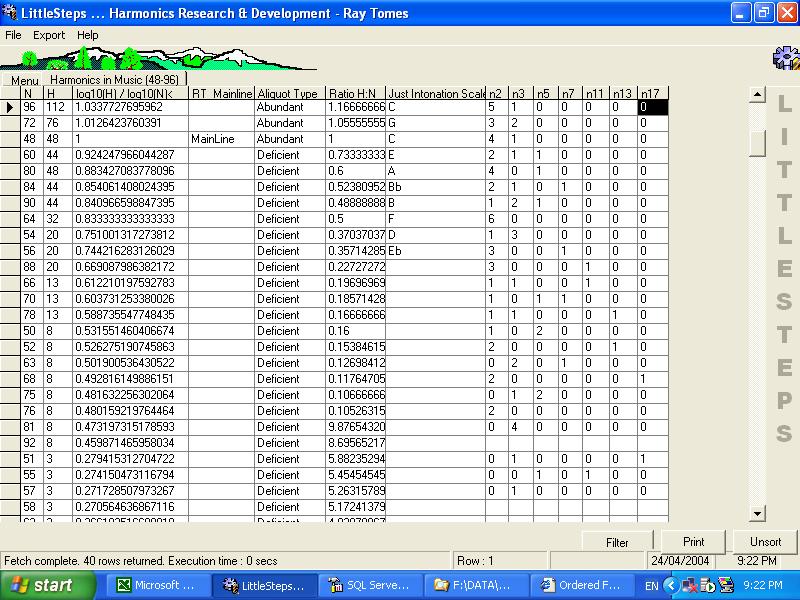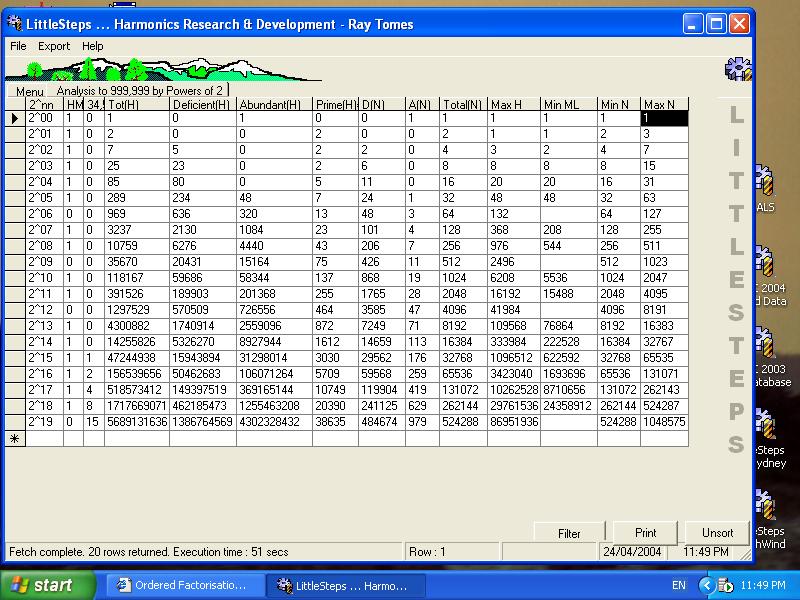 |
|||||||
|---|---|---|---|---|---|---|---|
 |
Number of Ordered | Primitive computational analyses | Web Publication by Mountain Man Graphics, Australia
 | ||||
 |
|||||||
|---|---|---|---|---|---|---|---|
 |
Number of Ordered | Primitive computational analyses | Web Publication by Mountain Man Graphics, Australia
 | ||||

Introduction |
|---|
The first section deals with the ability of the number of ordered factorization to account for the harmonic relationships evident in the musical Just Intonation Scale, and introduces the notion of aliquot type.
The second section examines the ancient notion of aliquot type historically (Euclid) defined by summation of the component aliquots, and notes the three separate threads of number so formalised. Abundant numbers have the sum of their divisors greater than themselves, deficient numbers have the sum of their divisors less than themselves. In the middle, with the sum of their divisors exactly equal to the number are the "Perfect Numbers".
The issue of Perfect Numbers (see above reference) and their relationship to Mersenne Primes has recently been popularised in distributed computational arrangments over the internet. For the latest in prime technology visit www.mersenne.org.
The third section introduces a new application for these ancient aliquot types. A redefinition in terms of the number of ordered factorisations (divisors) for any given number (rather than the summation of the divisors) is investigated.
That is, we define the following categories in regard to
the number of ordered factorizations.
Let the number of ordered factors of n be H(n), then:
Based on these axiomatic definitions, an analysis of the distribution of these aliquot types is undertaken for increasingly larger samples of sets of numbers, and their corresponding number of ordered factorizations.
It is clearly established by computational rather than theoretical means, that while the major percentage of the total numbers are deficient, despite the percentage of abundant numbers dimishing to an exceedingly small fraction, the major percentage of the total number of ordered factorizations is in fact contributed by this small fraction of abundant numbers.
The scale of this abundance is very surpising at first, and requires some adjustment in thinking. This avenue of thought leads to what Ray Tomes has defined as being the mainline harmonic numbers, which are essentially the greatest of these abundant numbers in any "locality" of the number environment n.
I would be interested in any theoretical feedback and/or responses to this article. Please also send any references to any other articles or notes related to ordered factorizations.
Best wishes for now,
Pete Brown
Falls Creek
Australia
Southern Autumn of 2004

The Just Intonation Scale of Music |
|---|

The elements of the Just Intonation Scale are related by their common factors, and their association with one another which clearly tends towards the maximisation of this number of ordered factorizations.

The Ancient Classification of Aliquot Type |
|---|
About 300BC, Euclid wrote at Proposition 36, Book 4, of The Elements,
concerning the aliquot parts and perfect numbers ...
About 100AD, Nichomachus elucidated this classification system for numbers:
In the following section we propose a separate but related definition
based not upon the summation,
but upon the number (ie:count)
of the ordered factorizations.
AFAIK this new definition has not before been explicitly stated.
Should this not be the case, please inform the author.
Thanks.

Reclassification of the ancient Aliquot Type |
|---|
As can be seen in the table above, the numbers 96 and 72 are "abundant".
Where N = 96, H = 112 and where N = 72, H = 76.
These Balanced numbers have not been further distinguished in the following analyses.
As an aside, Ray Tomes has conjectured (April 2004) that the largest known balanced number is the number: 2^(2^13466918-4)*(2^13466917-1). This is a number with about 10^4053946 digits, (not 4053946 digits but 10^4053946 digits!!!), but perfectly balanced, having precisely 2^(2^13466918-4)*(2^13466917-1) ordered factorizations.

Analysis of the number of Ordered Factorization by Aliquot Types |
|---|

The above analysis was then somewhat extended to all n up to 16,777,216 (or to 2^23),
and percentage calculation columns were added to discern the trends of
relative distribution within these groups of the defined aliquot types.
|
Analysis
to 16,777,216 by Powers of 2 |
|
|
|
|
|||
|
2^nn |
Prime(N) |
%P(N) |
D(N) |
%D(N) |
A(N) |
%A(N) |
Total(N) |
|
2^00 |
0 |
0.0000 |
0 |
0.0000 |
1 |
100.0000 |
1 |
|
2^01 |
2 |
100.0000 |
0 |
0.0000 |
0 |
0.0000 |
2 |
|
2^02 |
2 |
50.0000 |
2 |
50.0000 |
0 |
0.0000 |
4 |
|
2^03 |
2 |
25.0000 |
6 |
75.0000 |
0 |
0.0000 |
8 |
|
2^04 |
5 |
31.2500 |
11 |
68.7500 |
0 |
0.0000 |
16 |
|
2^05 |
7 |
21.8750 |
24 |
75.0000 |
1 |
3.1250 |
32 |
|
2^06 |
13 |
20.3125 |
48 |
75.0000 |
3 |
4.6875 |
64 |
|
2^07 |
23 |
17.9688 |
101 |
78.9063 |
4 |
3.1250 |
128 |
|
2^08 |
43 |
16.7969 |
206 |
80.4688 |
7 |
2.7344 |
256 |
|
2^09 |
75 |
14.6484 |
426 |
83.2031 |
11 |
2.1484 |
512 |
|
2^10 |
137 |
13.3789 |
868 |
84.7656 |
19 |
1.8555 |
1,024 |
|
2^11 |
255 |
12.4512 |
1765 |
86.1816 |
28 |
1.3672 |
2,048 |
|
2^12 |
464 |
11.3281 |
3585 |
87.5244 |
47 |
1.1475 |
4,096 |
|
2^13 |
872 |
10.6445 |
7249 |
88.4888 |
71 |
0.8667 |
8,192 |
|
2^14 |
1,612 |
9.8389 |
14659 |
89.4714 |
113 |
0.6897 |
16,384 |
|
2^15 |
3,030 |
9.2468 |
29562 |
90.2161 |
176 |
0.5371 |
32,768 |
|
2^16 |
5,709 |
8.7112 |
59568 |
90.8936 |
259 |
0.3952 |
65,536 |
|
2^17 |
10,749 |
8.2008 |
119904 |
91.4795 |
419 |
0.3197 |
131,072 |
|
2^18 |
20,390 |
7.7782 |
241125 |
91.9819 |
629 |
0.2399 |
262,144 |
|
2^19 |
38,635 |
7.3690 |
484674 |
92.4442 |
979 |
0.1867 |
524,288 |
|
2^20 |
73,586 |
7.0177 |
973533 |
92.8433 |
1457 |
0.1390 |
1,048,576 |
|
2^21 |
140,336 |
6.6917 |
1954482 |
93.1970 |
2334 |
0.1113 |
2,097,152 |
|
2^22 |
268,216 |
6.3948 |
3922629 |
93.5228 |
3459 |
0.0825 |
4,194,304 |
|
2^23 |
513,708 |
6.1239 |
7869549 |
93.8123 |
5352 |
0.0638 |
8,388,609 |
|
|
|
|
|
|
|
|
|
|
Totals |
1,077,871 |
6.4246 |
15683976 |
93.4838 |
15369 |
0.0916 |
16,777,216 |
In summary we might note that the deficient numbers (along with a dimishing number of prime numbers) dominate the first 16.777 million integers, with 99.9% of number. The percentage of the abundant ordered factorizations in this range can clearly be seen to represent only the modest percentage of 0.0916.
|
Analysis
to 16,777,216 by Powers of 2 |
|
|
|
|
|||
|
2^nn |
Tot(H) |
%D(H) |
Deficient(H) |
%A(H) |
Abundant(H) |
%P(H) |
Prime(H)=P(N) |
|
2^00 |
1 |
0.0000 |
0 |
100.0000 |
1 |
0.0000 |
0 |
|
2^01 |
2 |
0.0000 |
0 |
0.0000 |
0 |
100.0000 |
2 |
|
2^02 |
7 |
71.4286 |
5 |
0.0000 |
0 |
28.5714 |
2 |
|
2^03 |
25 |
92.0000 |
23 |
0.0000 |
0 |
8.0000 |
2 |
|
2^04 |
85 |
94.1176 |
80 |
0.0000 |
0 |
5.8824 |
5 |
|
2^05 |
289 |
80.9689 |
234 |
16.6090 |
48 |
2.4221 |
7 |
|
2^06 |
969 |
65.6347 |
636 |
33.0237 |
320 |
1.3416 |
13 |
|
2^07 |
3,237 |
65.8017 |
2,130 |
33.4878 |
1,084 |
0.7105 |
23 |
|
2^08 |
10,759 |
58.3326 |
6,276 |
41.2678 |
4,440 |
0.3997 |
43 |
|
2^09 |
35,670 |
57.2778 |
20,431 |
42.5119 |
15,164 |
0.2103 |
75 |
|
2^10 |
118,167 |
50.5099 |
59,686 |
49.3742 |
58,344 |
0.1159 |
137 |
|
2^11 |
391,526 |
48.5033 |
189,903 |
51.4316 |
201,368 |
0.0651 |
255 |
|
2^12 |
1,297,529 |
43.9689 |
570,509 |
55.9954 |
726,556 |
0.0358 |
464 |
|
2^13 |
4,300,882 |
40.4781 |
1,740,914 |
59.5017 |
2,559,096 |
0.0203 |
872 |
|
2^14 |
14,255,826 |
37.3621 |
5,326,270 |
62.6266 |
8,927,944 |
0.0113 |
1,612 |
|
2^15 |
47,244,938 |
33.7473 |
15,943,894 |
66.2463 |
31,298,014 |
0.0064 |
3,030 |
|
2^16 |
156,539,656 |
32.2364 |
50,462,683 |
67.7600 |
106,071,264 |
0.0036 |
5,709 |
|
2^17 |
518,573,412 |
28.8093 |
149,397,519 |
71.1886 |
369,165,144 |
0.0021 |
10,749 |
|
2^18 |
1,717,669,071 |
26.9077 |
462,185,473 |
73.0911 |
1,255,463,208 |
0.0012 |
20,390 |
|
2^19 |
5,689,131,636 |
24.3757 |
1,386,764,569 |
75.6236 |
4,302,328,432 |
0.0007 |
38,635 |
|
2^20 |
18,843,448,795 |
22.8560 |
4,306,860,069 |
77.1436 |
14,536,515,140 |
0.0004 |
73,586 |
|
2^21 |
62,417,265,668 |
20.3462 |
12,699,535,156 |
79.6536 |
49,717,590,176 |
0.0002 |
140,336 |
|
2^22 |
206,771,806,824 |
18.8015 |
38,876,235,196 |
81.1984 |
167,895,303,412 |
0.0001 |
268,216 |
|
2^23 |
685,060,801,921 |
17.0794 |
117,004,573,089 |
82.9205 |
568,055,715,124 |
0.0001 |
513,708 |
|
|
|
|
|
|
|
|
|
|
Totals |
981,242,896,895 |
17.8304 |
174,959,874,745 |
82.1695 |
806,281,944,279 |
0.0001 |
1,077,871 |
In summary we might note that in the first 16.777 million integers
the abundant ordered factorizations are represented by only the modest percentage of 0.0916% (of numbers),
yet they account for 82.1695% of the total number of ordered factorizations.

Summary and Conclusions |
|---|
These results suggest that the ancient concept of "abundance" may be validly applied to more than the summation of factors. The new definition - by number of ordered factorizations - of deficient and abundant appears to be vindicated by the above analysis, and suggests further research might prove rewarding.
These results also support the hypotheses outlined in the Theory of Harmonics by Ray Tomes, in which critical emphasis is placed upon a defined harmonic mainline series which is represented by the most abundant of the abundant ordered factorizations.
PRF Brown
Falls Creek
Australia
